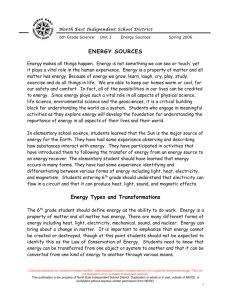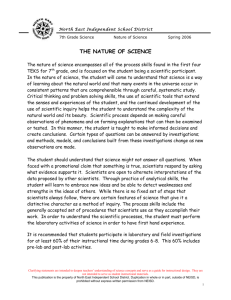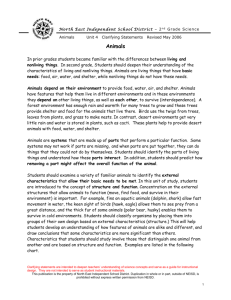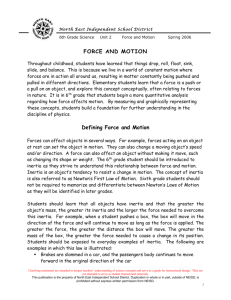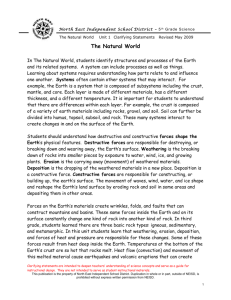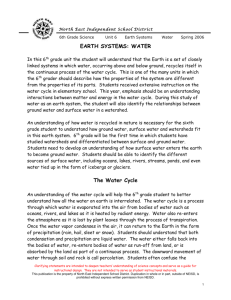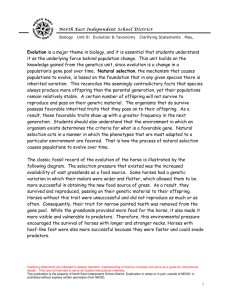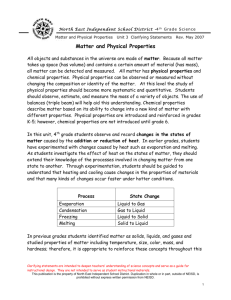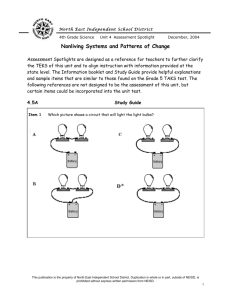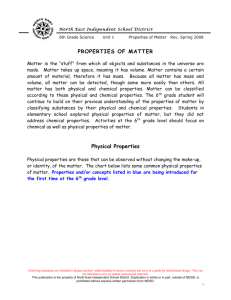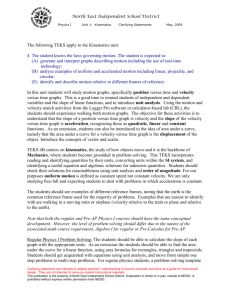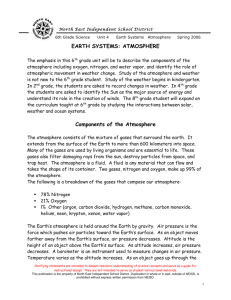6th grade Energy - North East Independent School District
advertisement
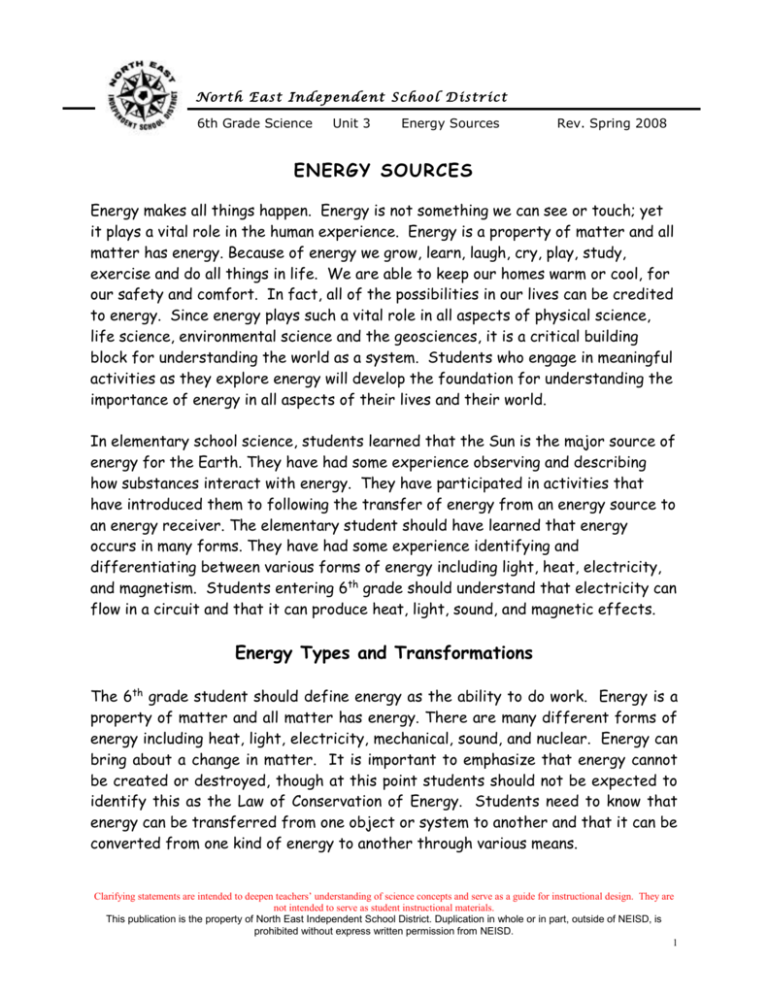
N o r th E a s t In d e pen d e nt S c ho o l Di s tr ic t 6th Grade Science Unit 3 Energy Sources Rev. Spring 2008 ENERGY SOURCES Energy makes all things happen. Energy is not something we can see or touch; yet it plays a vital role in the human experience. Energy is a property of matter and all matter has energy. Because of energy we grow, learn, laugh, cry, play, study, exercise and do all things in life. We are able to keep our homes warm or cool, for our safety and comfort. In fact, all of the possibilities in our lives can be credited to energy. Since energy plays such a vital role in all aspects of physical science, life science, environmental science and the geosciences, it is a critical building block for understanding the world as a system. Students who engage in meaningful activities as they explore energy will develop the foundation for understanding the importance of energy in all aspects of their lives and their world. In elementary school science, students learned that the Sun is the major source of energy for the Earth. They have had some experience observing and describing how substances interact with energy. They have participated in activities that have introduced them to following the transfer of energy from an energy source to an energy receiver. The elementary student should have learned that energy occurs in many forms. They have had some experience identifying and differentiating between various forms of energy including light, heat, electricity, and magnetism. Students entering 6th grade should understand that electricity can flow in a circuit and that it can produce heat, light, sound, and magnetic effects. Energy Types and Transformations The 6th grade student should define energy as the ability to do work. Energy is a property of matter and all matter has energy. There are many different forms of energy including heat, light, electricity, mechanical, sound, and nuclear. Energy can bring about a change in matter. It is important to emphasize that energy cannot be created or destroyed, though at this point students should not be expected to identify this as the Law of Conservation of Energy. Students need to know that energy can be transferred from one object or system to another and that it can be converted from one kind of energy to another through various means. Clarifying statements are intended to deepen teachers’ understanding of science concepts and serve as a guide for instructional design. They are not intended to serve as student instructional materials. This publication is the property of North East Independent School District. Duplication in whole or in part, outside of NEISD, is prohibited without express written permission from NEISD. 1 N o r th E a s t In d e pen d e nt S c ho o l Di s tr ic t 6th Grade Science Unit 3 Energy Sources Rev. Spring 2008 Various forms of energy that students should be familiar with include: Mechanical energy: this is the energy an object has because of its motion or position (students do not need to be assessed over the concept of potential vs. kinetic at this time as this concept is a part of the 7th grade TEKS) Thermal energy (or heat energy): the energy related to the temperature of a substance Radiant/Solar energy: the energy carried by light and other kinds of electromagnetic waves (students do not need to learn the EM spectrum at this level as they will be introduced to this concept in 8th grade) Sound energy: the energy carried by sound waves, caused by an object’s vibrations Electrical energy: the energy produced by electric charges Chemical energy: the energy stored in a substance that is released in a chemical reaction Students in 6th grade need to be able to identify energy transformations that take place during the production of energy for human use. Students should also recognize that in many situations, one type of energy is being transformed into multiple other types of energy. For example, a hair dryer transforms electrical energy into mechanical, thermal, and sound energy. An important concept is that the ultimate source of energy for use is radiant energy from the sun. Thermal energy from the sun warms the earth and makes life possible. Light energy from the sun stimulates photosynthesis, allowing plants to produce their own food which in turn becomes food for us and all other consumers. The chemical energy from this food is transformed again into mechanical energy as our bodies use it for all daily activities. Students will need practice in recognizing the different forms of chemical energy, such as that stored in food as well as batteries and fuel. Clarifying statements are intended to deepen teachers’ understanding of science concepts and serve as a guide for instructional design. They are not intended to serve as student instructional materials. This publication is the property of North East Independent School District. Duplication in whole or in part, outside of NEISD, is prohibited without express written permission from NEISD. 2 N o r th E a s t In d e pen d e nt S c ho o l Di s tr ic t 6th Grade Science Unit 3 Energy Sources Rev. Spring 2008 Students will examine how different devices or machines can also transform energy for human use. Examples should include water heaters, cooling systems, hydroelectric plants, and wind power plants. It is not important for students to be able to memorize each and every step that occurs in the function of these devices. It is more important for students to have a conceptual understanding that these devices are systems in which multiple steps of energy transformation takes place, just as energy transformation takes place in natural systems. The following illustrates an example of the energy transformations that take place when utilizing coal to power electricity in a home. Note in the first illustration that the energy chain begins with radiant energy from the sun. Clarifying statements are intended to deepen teachers’ understanding of science concepts and serve as a guide for instructional design. They are not intended to serve as student instructional materials. This publication is the property of North East Independent School District. Duplication in whole or in part, outside of NEISD, is prohibited without express written permission from NEISD. 3 N o r th E a s t In d e pen d e nt S c ho o l Di s tr ic t 6th Grade Science Unit 3 Energy Sources Rev. Spring 2008 An Energy Chain: Coal and oxygen flame steam turbine generator light bulb light & heat Clarifying statements are intended to deepen teachers’ understanding of science concepts and serve as a guide for instructional design. They are not intended to serve as student instructional materials. This publication is the property of North East Independent School District. Duplication in whole or in part, outside of NEISD, is prohibited without express written permission from NEISD. 4 N o r th E a s t In d e pen d e nt S c ho o l Di s tr ic t 6th Grade Science Unit 3 Energy Sources Rev. Spring 2008 Students in 6th grade will be introduced to the concept of interactions that occur between matter and energy in the decay of biomass within a compost bin. Biomass is organic material made from plants and animals. Biomass contains stored energy from the sun. Biomass is a renewable energy source because we can always grow more trees and crops, and waste will always exist. Some examples of biomass fuels are wood, crops, manure, and some garbage. Compost is made up of matter such as discarded fruit and vegetables, grass clippings, sawdust, newspapers, leaves and twigs. As the materials break down over time, they produce fertilizer for plants; this is also called biomass. Students should also see energy transformations in a broader context than physical systems. The following food web illustrates an example of the number of organisms which can transform or utilize the energy from the compost pile. It is not intended for memorization, but to provide an example of energy transformations in living systems. Clarifying statements are intended to deepen teachers’ understanding of science concepts and serve as a guide for instructional design. They are not intended to serve as student instructional materials. This publication is the property of North East Independent School District. Duplication in whole or in part, outside of NEISD, is prohibited without express written permission from NEISD. 5 N o r th E a s t In d e pen d e nt S c ho o l Di s tr ic t 6th Grade Science Unit 3 Energy Sources Rev. Spring 2008 Energy Sources Students need to know that different forms of energy are stored in different ways. Energy originates from a natural resource and can be transformed into other types of energy. Sources of energy are classified as renewable, nonrenewable, or inexhaustible resources. Students should be familiar with these terms from 5th grade. The following lists examples of each type of resource: Clarifying statements are intended to deepen teachers’ understanding of science concepts and serve as a guide for instructional design. They are not intended to serve as student instructional materials. This publication is the property of North East Independent School District. Duplication in whole or in part, outside of NEISD, is prohibited without express written permission from NEISD. 6 N o r th E a s t In d e pen d e nt S c ho o l Di s tr ic t 6th Grade Science Unit 3 Energy Sources Rev. Spring 2008 Renewable energy comes from resources that can be used and replaced over a short period of time. Plants and animals provide their consumers with chemical energy. Water is often used as a clean energy source to turn the turbines in a hydroelectric dam, activating a generator to change mechanical energy into electrical energy. Non-renewable energy is obtained from resources that cannot be replaced or may take thousands or millions of years to replace. Most non-renewable resources are classified as fossil fuels. Fossil fuels formed from the buried remains of plants and animals that lived millions of years ago. Energy that was stored in the plants and animals from photosynthesis or the foods that were consumed is burned in order to power our homes and fuel our vehicles. Inexhaustible energy is from a resource that cannot be used up. The mechanical energy of wind turns the blades of windmills and turbines which in turn power a generator to provide electricity. The sun’s radiant energy is the ultimate inexhaustible resource that warms our earth and stimulates photosynthesis in producers. Clarifying statements are intended to deepen teachers’ understanding of science concepts and serve as a guide for instructional design. They are not intended to serve as student instructional materials. This publication is the property of North East Independent School District. Duplication in whole or in part, outside of NEISD, is prohibited without express written permission from NEISD. 7
